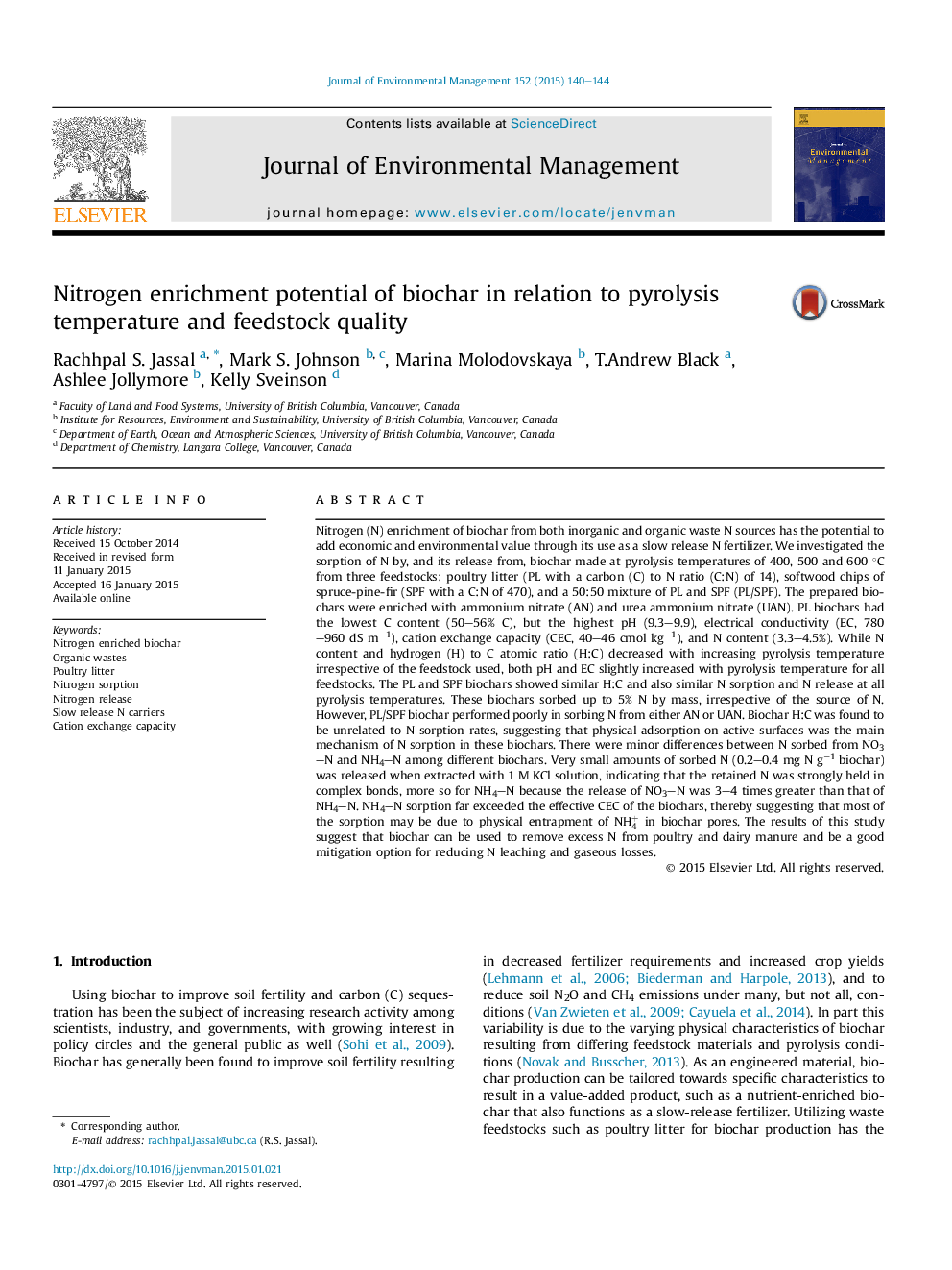| کد مقاله | کد نشریه | سال انتشار | مقاله انگلیسی | نسخه تمام متن |
|---|---|---|---|---|
| 7482562 | 1485260 | 2015 | 5 صفحه PDF | دانلود رایگان |
عنوان انگلیسی مقاله ISI
Nitrogen enrichment potential of biochar in relation to pyrolysis temperature and feedstock quality
ترجمه فارسی عنوان
پتانسیل غنی سازی نیتروژن زغال چوب در رابطه با درجه حرارت پیلوریس و کیفیت مواد اولیه
دانلود مقاله + سفارش ترجمه
دانلود مقاله ISI انگلیسی
رایگان برای ایرانیان
کلمات کلیدی
موضوعات مرتبط
مهندسی و علوم پایه
مهندسی انرژی
انرژی های تجدید پذیر، توسعه پایدار و محیط زیست
چکیده انگلیسی
Nitrogen (N) enrichment of biochar from both inorganic and organic waste N sources has the potential to add economic and environmental value through its use as a slow release N fertilizer. We investigated the sorption of N by, and its release from, biochar made at pyrolysis temperatures of 400, 500 and 600 °C from three feedstocks: poultry litter (PL with a carbon (C) to N ratio (C:N) of 14), softwood chips of spruce-pine-fir (SPF with a C:N of 470), and a 50:50 mixture of PL and SPF (PL/SPF). The prepared biochars were enriched with ammonium nitrate (AN) and urea ammonium nitrate (UAN). PL biochars had the lowest C content (50-56% C), but the highest pH (9.3-9.9), electrical conductivity (EC, 780-960 dS mâ1), cation exchange capacity (CEC, 40-46 cmol kgâ1), and N content (3.3-4.5%). While N content and hydrogen (H) to C atomic ratio (H:C) decreased with increasing pyrolysis temperature irrespective of the feedstock used, both pH and EC slightly increased with pyrolysis temperature for all feedstocks. The PL and SPF biochars showed similar H:C and also similar N sorption and N release at all pyrolysis temperatures. These biochars sorbed up to 5% N by mass, irrespective of the source of N. However, PL/SPF biochar performed poorly in sorbing N from either AN or UAN. Biochar H:C was found to be unrelated to N sorption rates, suggesting that physical adsorption on active surfaces was the main mechanism of N sorption in these biochars. There were minor differences between N sorbed from NO3-N and NH4-N among different biochars. Very small amounts of sorbed N (0.2-0.4 mg N gâ1 biochar) was released when extracted with 1 M KCl solution, indicating that the retained N was strongly held in complex bonds, more so for NH4-N because the release of NO3-N was 3-4 times greater than that of NH4-N. NH4-N sorption far exceeded the effective CEC of the biochars, thereby suggesting that most of the sorption may be due to physical entrapment of NH4+ in biochar pores. The results of this study suggest that biochar can be used to remove excess N from poultry and dairy manure and be a good mitigation option for reducing N leaching and gaseous losses.
ناشر
Database: Elsevier - ScienceDirect (ساینس دایرکت)
Journal: Journal of Environmental Management - Volume 152, 1 April 2015, Pages 140-144
Journal: Journal of Environmental Management - Volume 152, 1 April 2015, Pages 140-144
نویسندگان
Rachhpal S. Jassal, Mark S. Johnson, Marina Molodovskaya, T. Andrew Black, Ashlee Jollymore, Kelly Sveinson,
